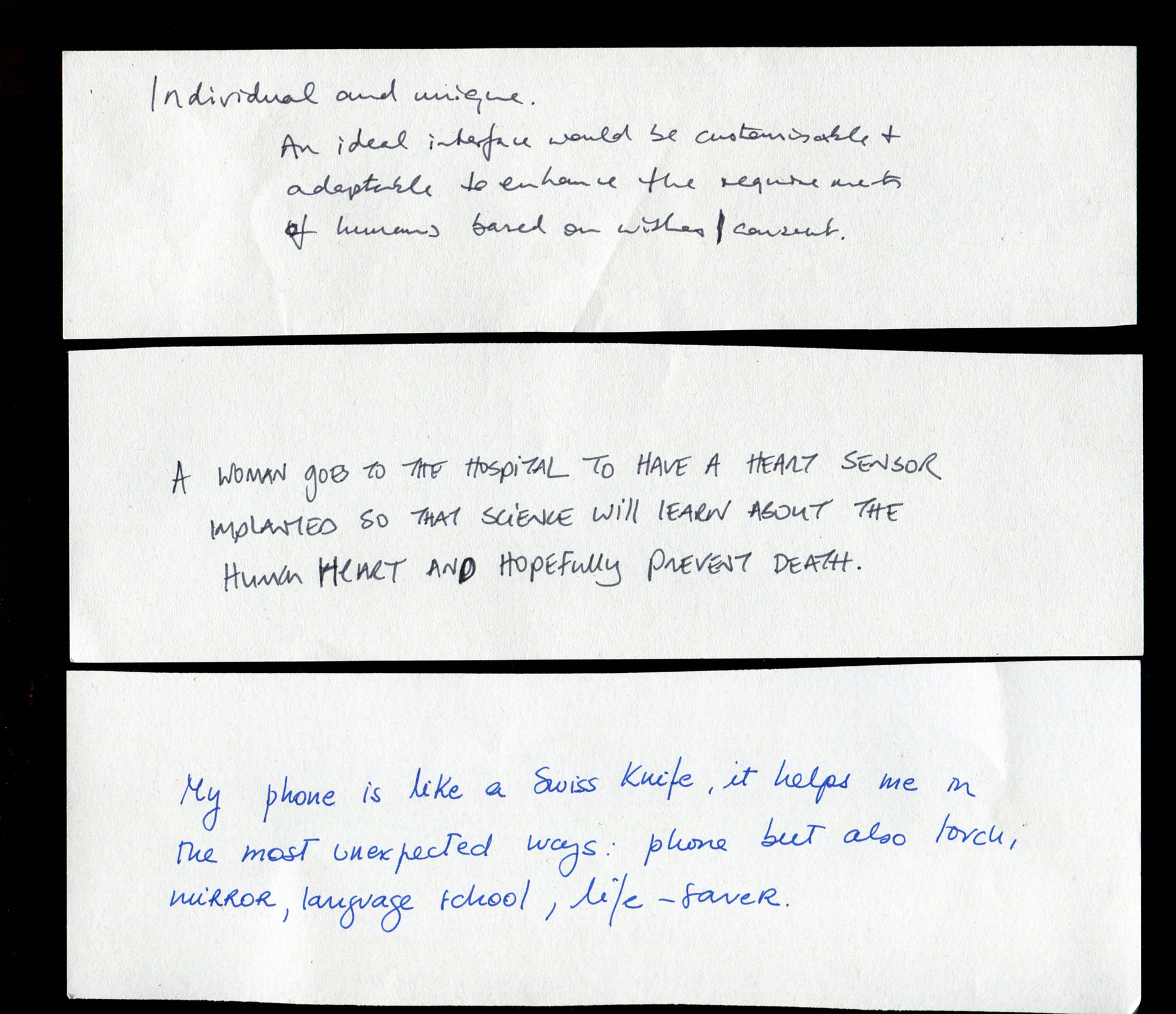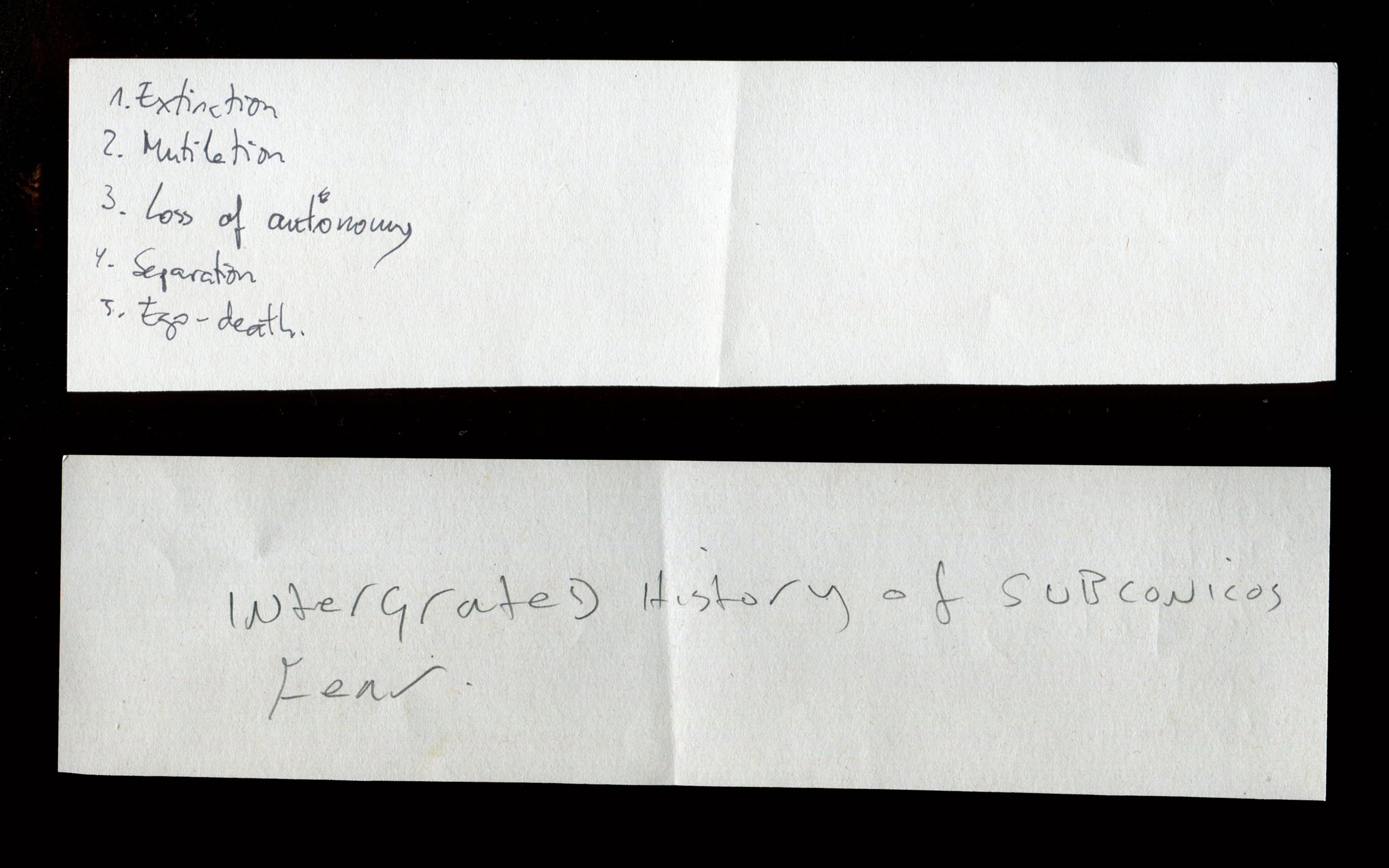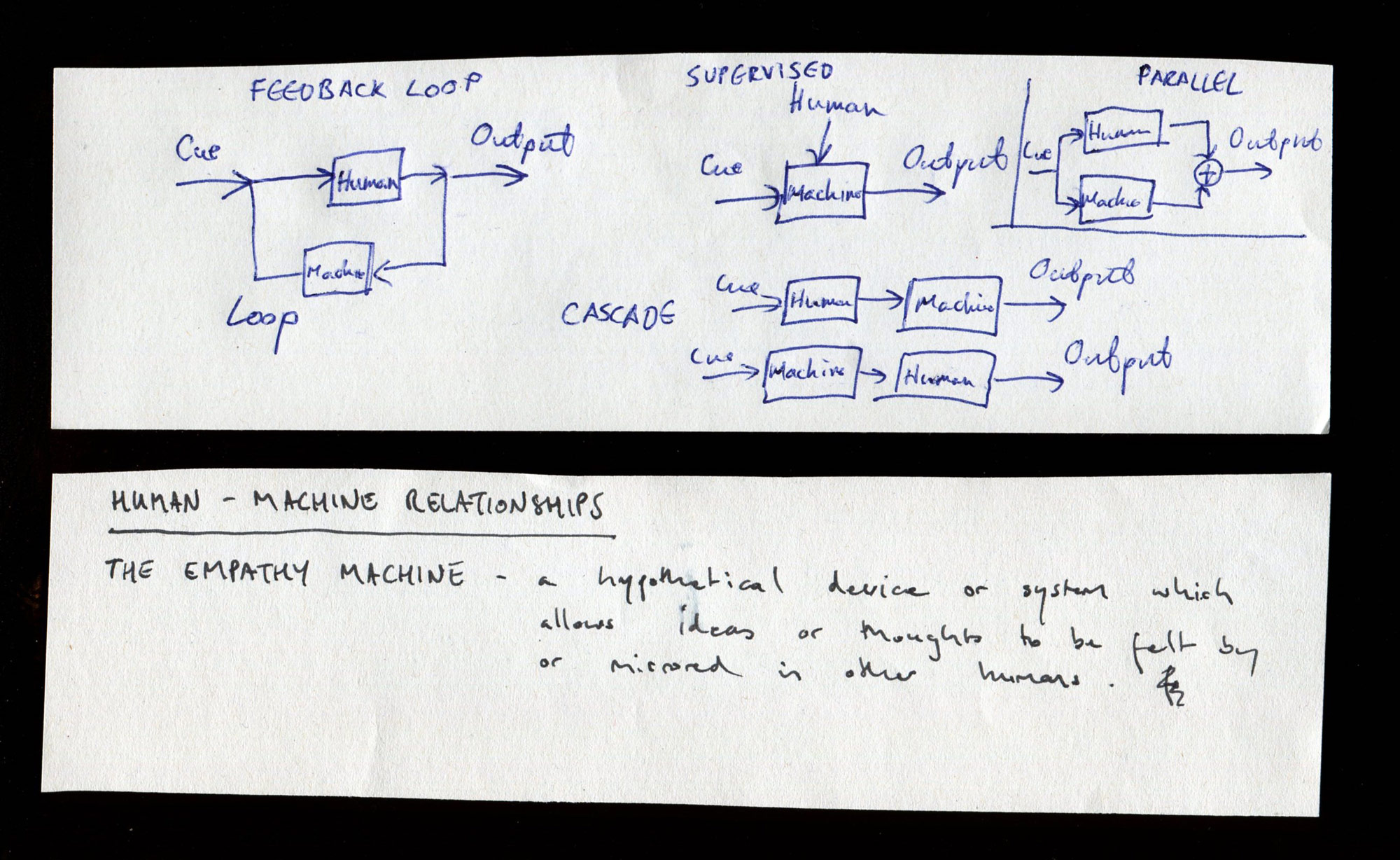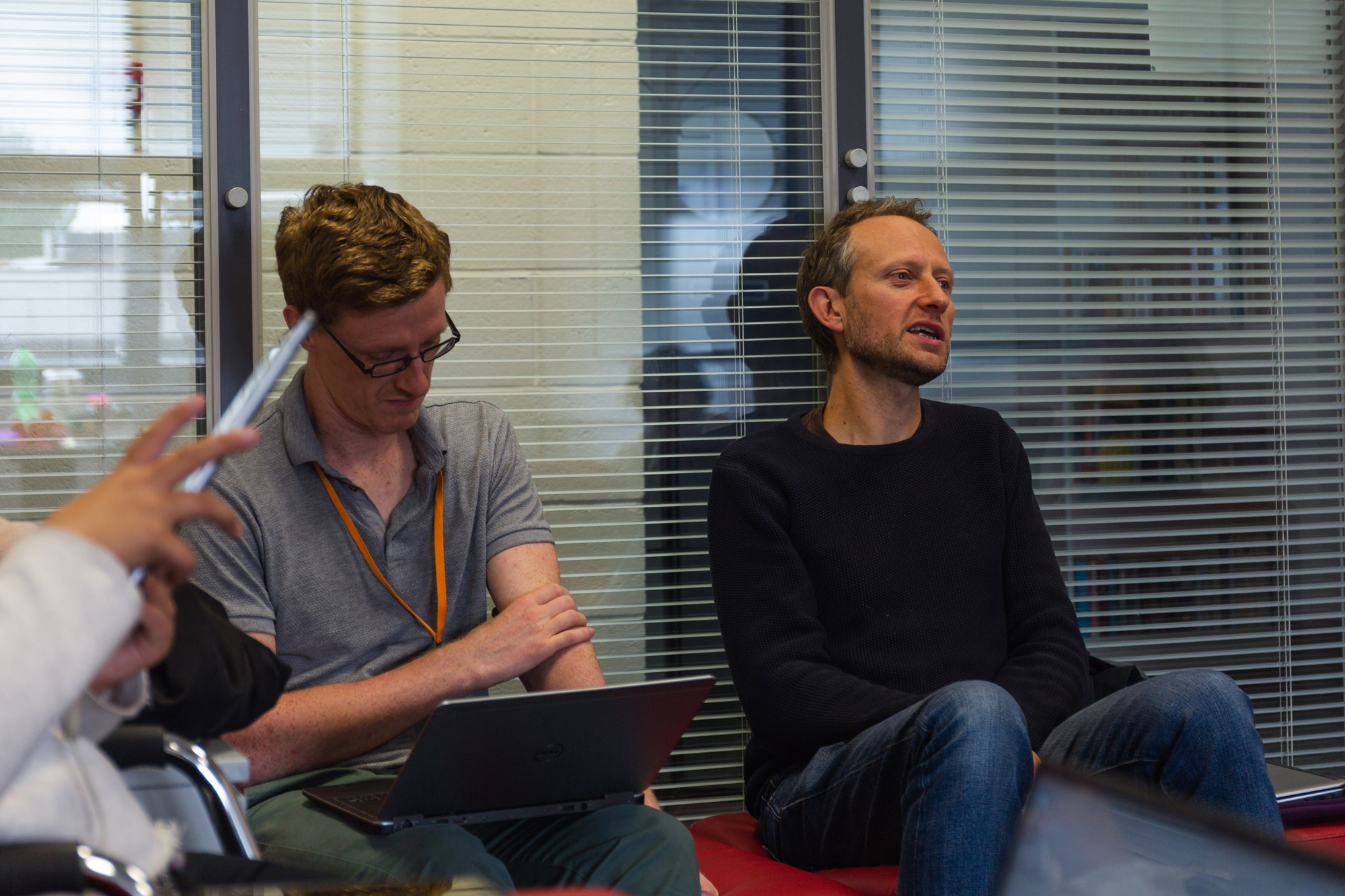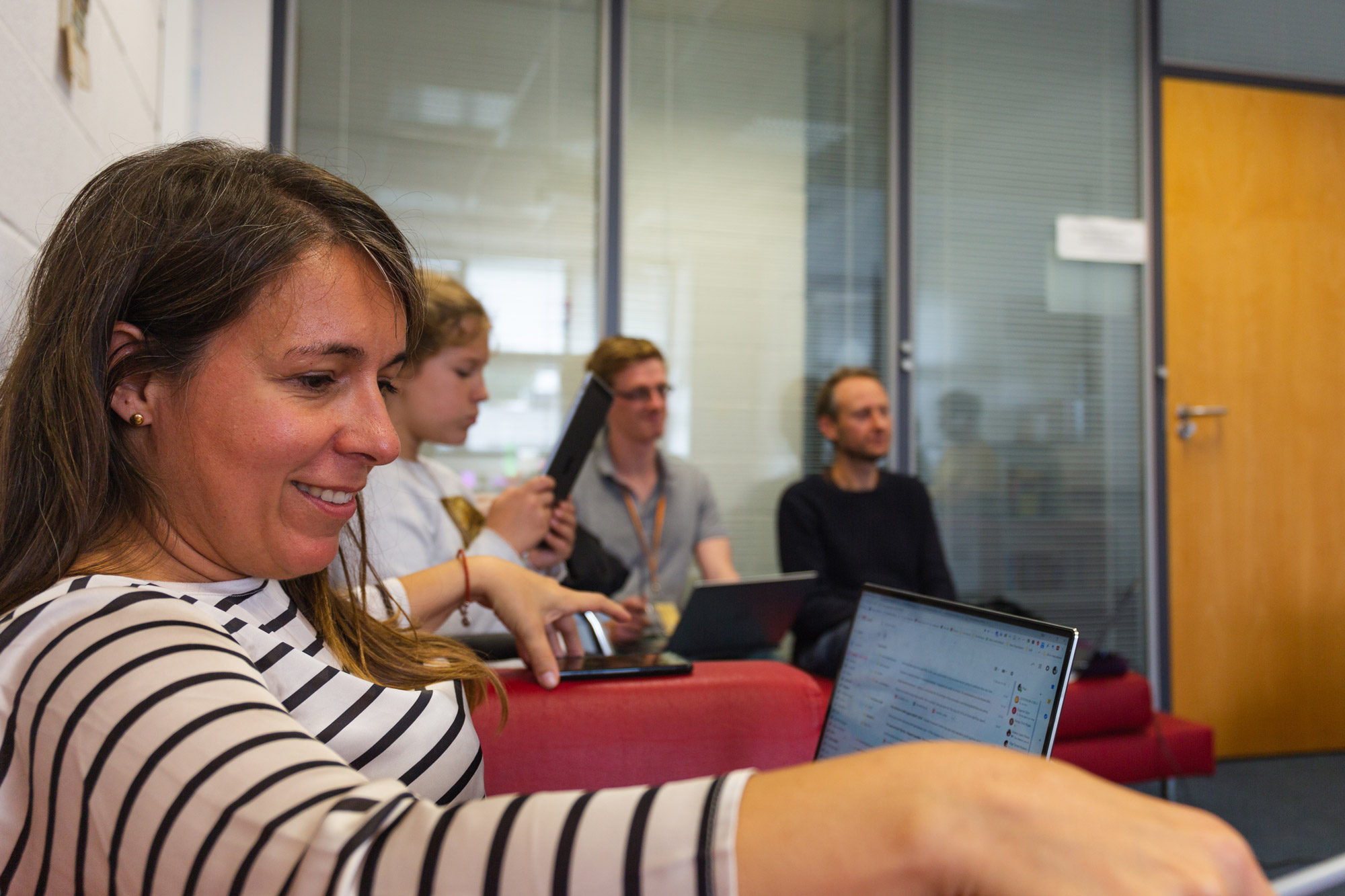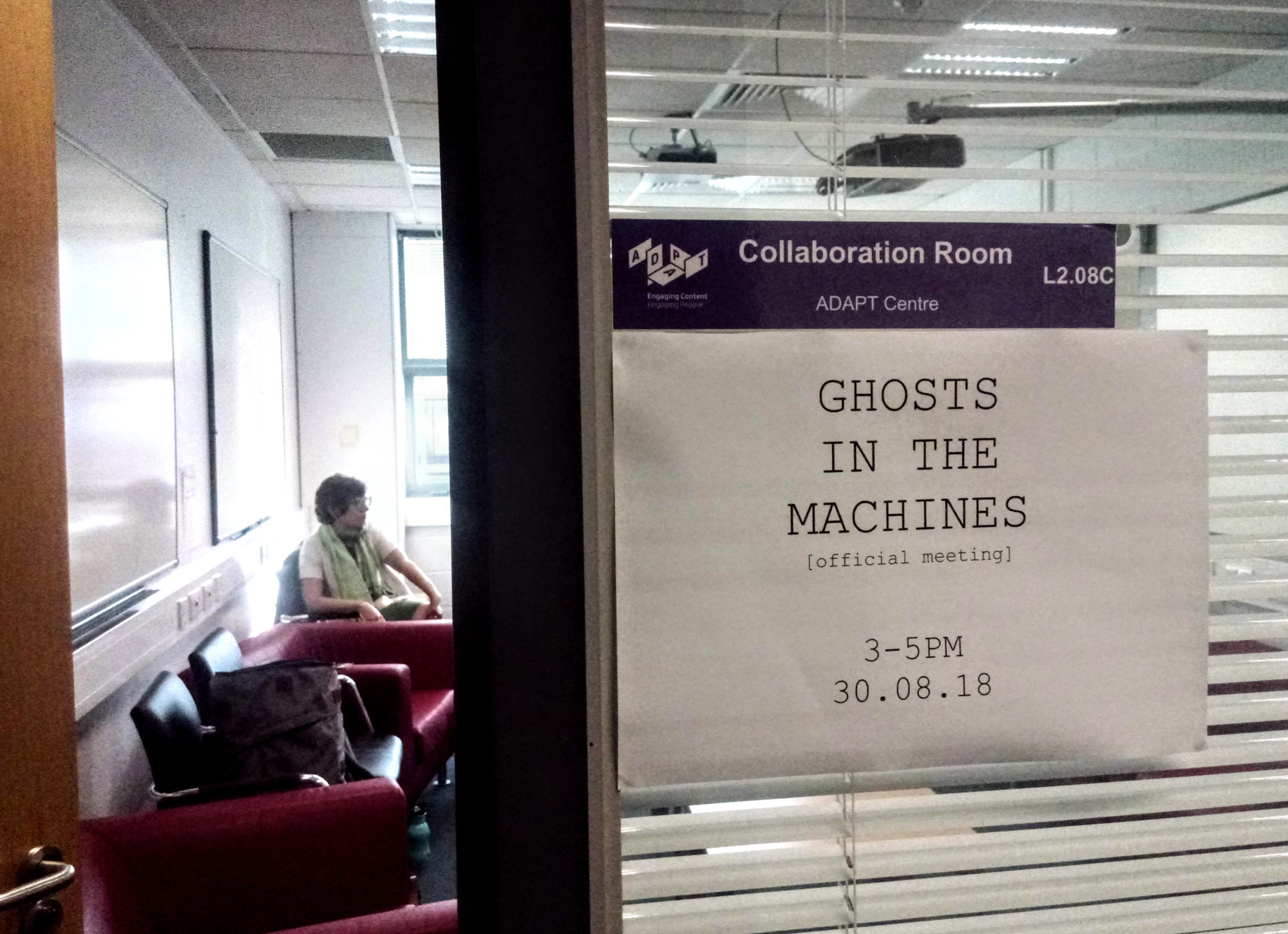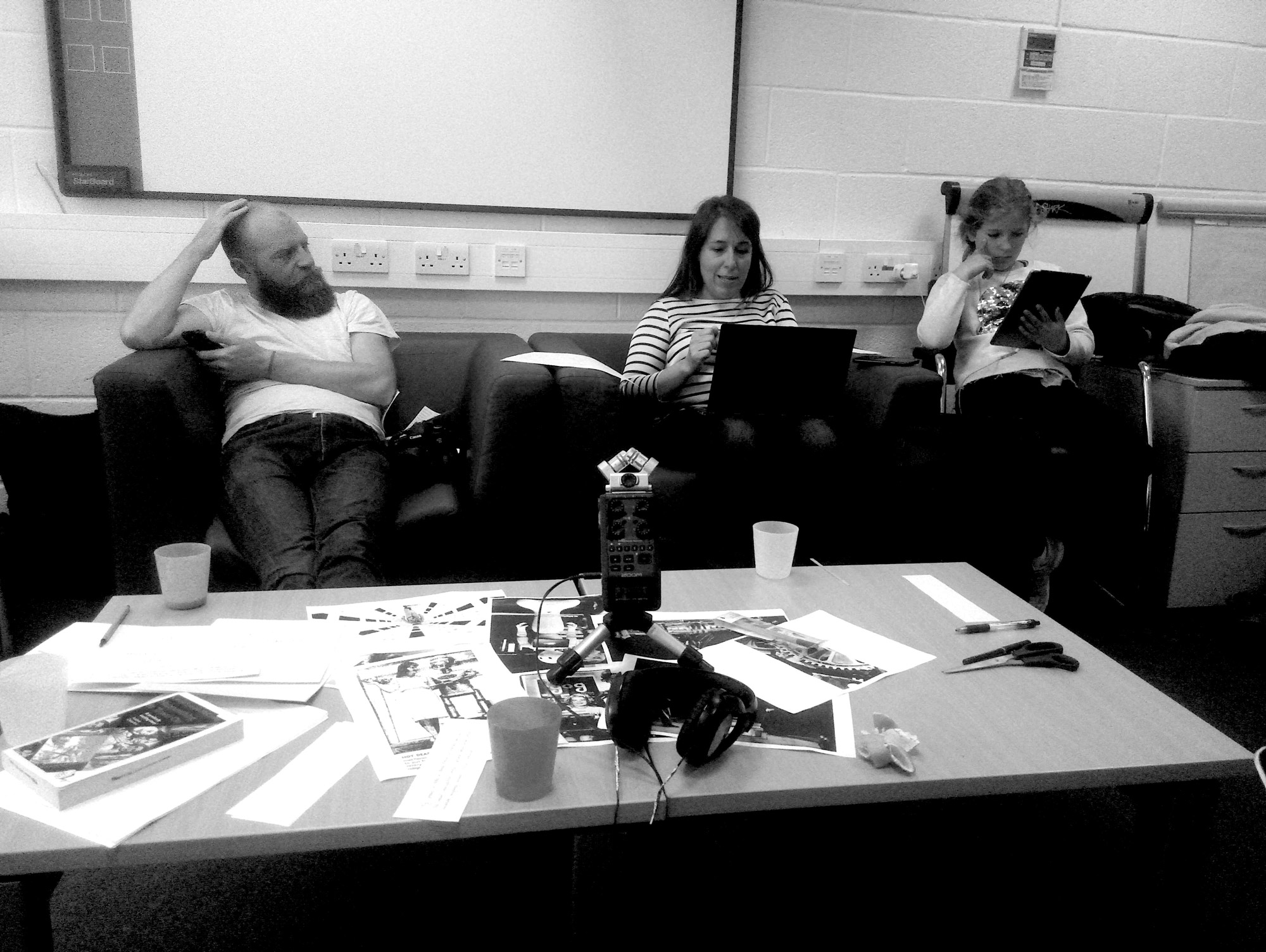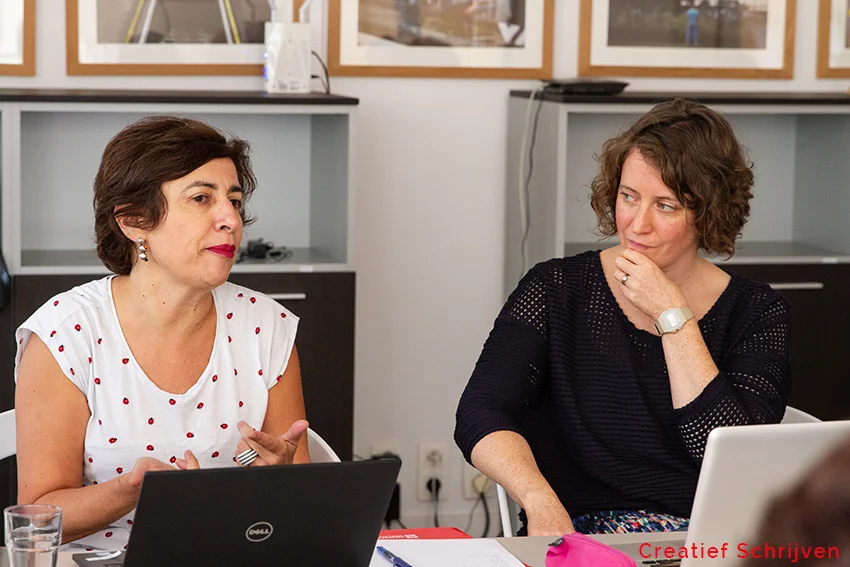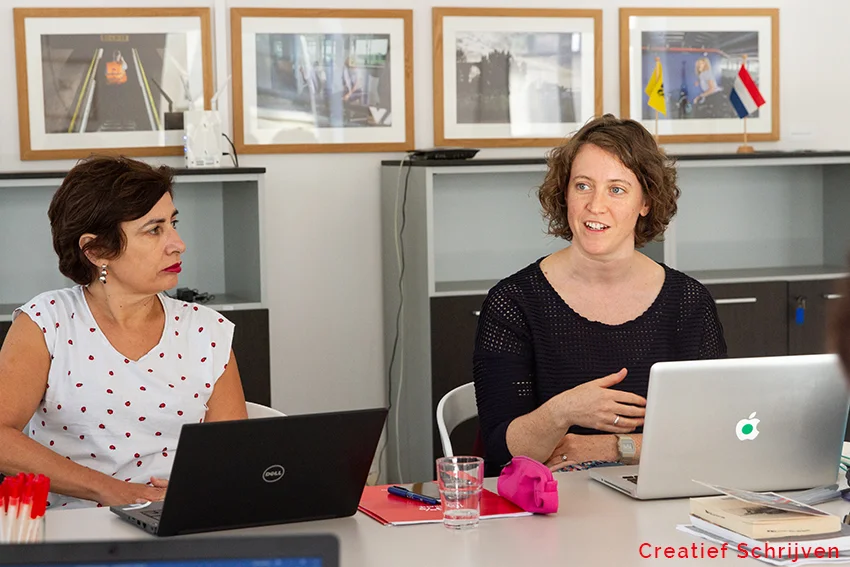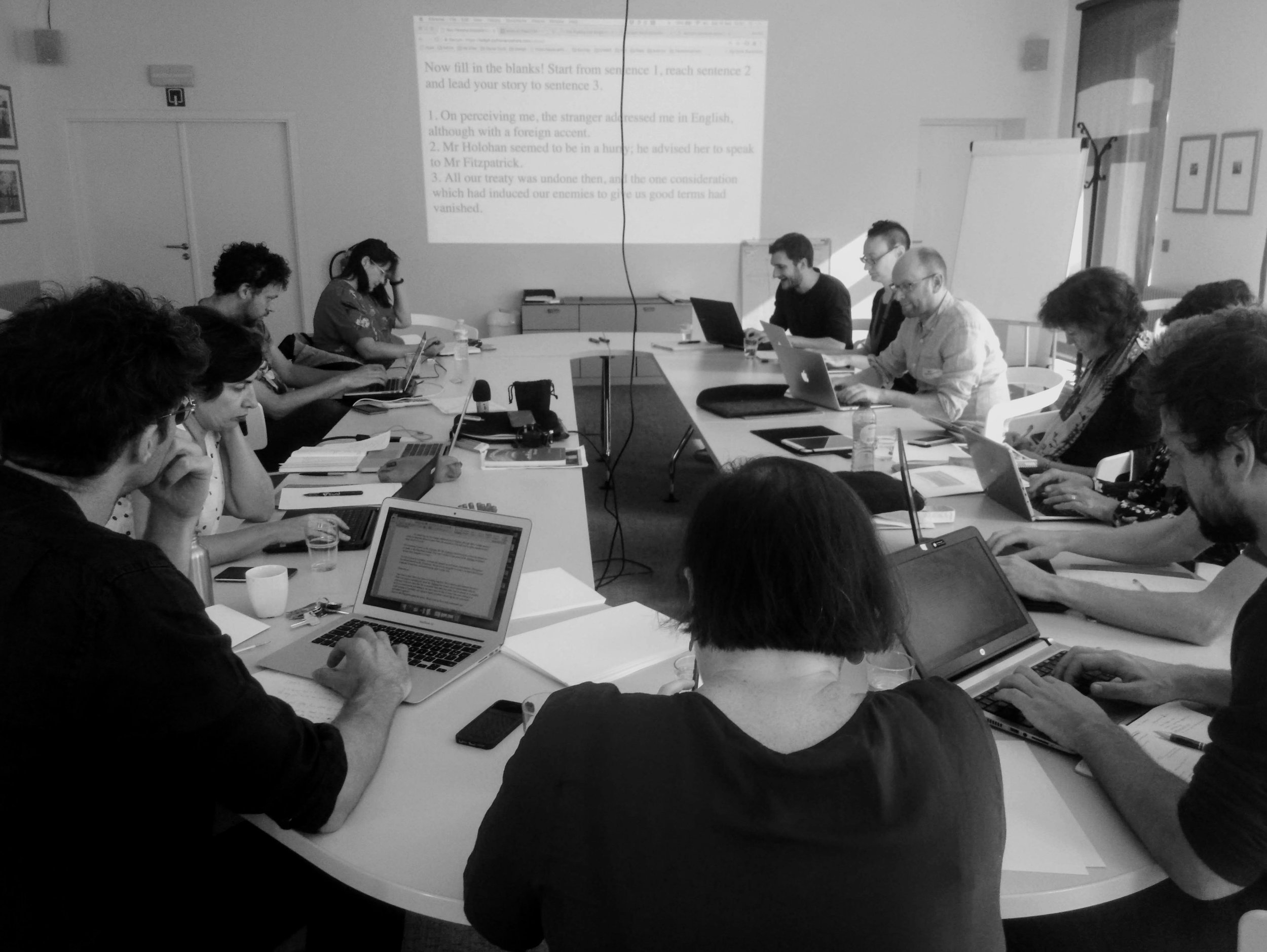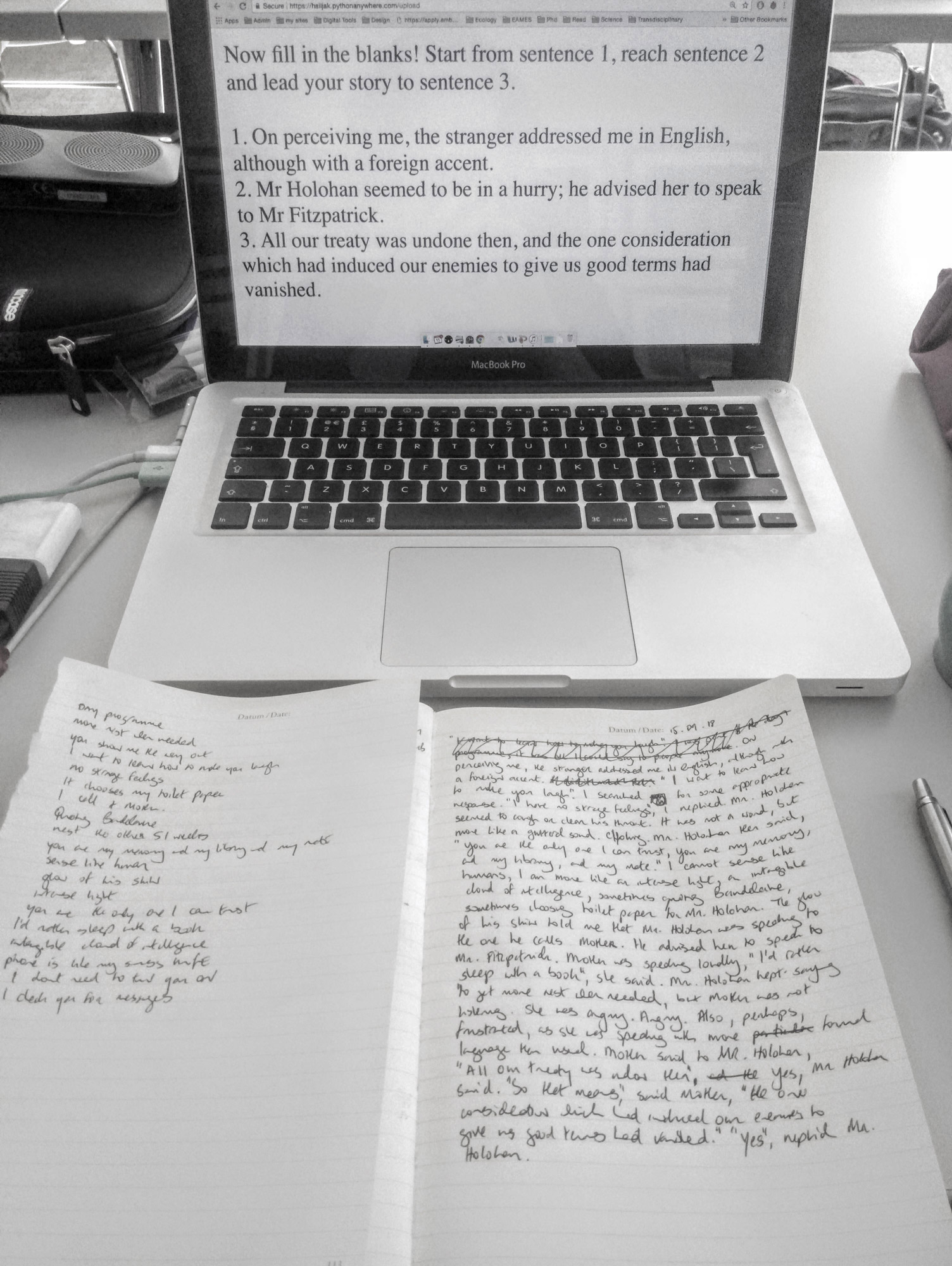Ghosts in the Machines
Imagine an age of machine intelligence where digital computers linked with vast databases have accumulated all knowledge in the world and can now generate better quality works of art and technology than humans on their own; Imagine that the laws, letters and testimony of machines has come to dominate and shape culture at every level; Imagine, a grassroots movement to demonstrate, against the odds, that humans and machines can develop a mutual relationship as creative companions; Welcome to the world of Ghosts in the Machines...
This is where Ana brought us, deep into the ambivalent world of human-computer-machine relationships. As a translator, creative writer and creative writing teacher working in the field of machine-translation and human-computer interaction, Ana Guerberhof was more than a double-agent. The machine-translation technologies she was helping to develop as a post-doctoral researcher with EDGE were the very technologies that seemed to threaten her vocation as writer, translator and teacher. I'm not sure exactly where the idea of Ghosts in the Machines came from, but it popped up during one of our many conversations and it certainly got us thinking. It made me begin to appreciate how poetry and machines could be related in many ways, just as poet William Carlos Williams said: “A poem is a small (or large) machine made of words” (1944). This was a seed that perplexed us and challenged us to think into clichés of human-machine relationships, power, technophilia and technophobia.
Modern Times, Chaplin
In the same spirit as the Peer Review session, Ana wanted to enact Ghosts in the Machines as a fictional guerrilla organisation determined to demonstrate the artistic capacities of machines. This was a kind of institutional critique, calling out narratives around the growing 'intelligence' of machines by actively inhabiting alarmist stories of machine-to-machine intelligence and declaring, 'yes, machines can make art better than any human'. Provocation station! Initially, Ana wanted us to act 'as if' machines were better writers than humans so that we could begin to imagine and speculatively inhabit what that world was like. So, Stranger Fictions was becoming a way for EDGE fellows and their associated networks to create a conceptual and experimental space where we could collectively “contemplate the possible and incubate political desires.” (Jon K. Shaw and Theo Reeves-Evison, Fiction as Method, 2017). Here's an excerpt from an early conversation between Ana, myself and Harun as we try to understand how the seed Ghosts in the Machines might work:
J: I’m actually kind of liking the idea that we take the 'ghosts in the machines' literally, and say this is an advocacy group, we recognise that the world is being populated more and more by digital machines (and sensor technologies) that are going to take over a certain amount of labour and that they are going to begin to develop their own, and already have, massively rapid language, machine to machine literature. And that humans, goddess help them, are going to need some kind of translator in between, and that the advocacy group is proposing ghosts in the machines as a literal device to create these kind of machine intelligence literary agents that will translate the machines for the human but will also have their own role as scribes and poets in the world.
H: I don’t know if we are going to emancipate these ghosts. They might turn into partners…
J: That’s it. They might become our spirit guides – I think thats the premise of the lobby group…
H: It all comes back to the slaves we made...
J: Yeah. these relationships seem to recur. I think Ana, that is probably what we are seeing as a kind of a red thread through the workshops that we’re doing is really an ethical question of relationship between humans, between what humans make and what tools they use and how they use them. I think that’s the common thread of what we are exploring. It's basically the ethics of what we do now in the world, as technologists, as artists, whatever, as citizens. As basic auld humans who don’t have a clue what they’re doing.
A: But it’s funny, because you are seeing machines as a slave, right, while translators see machines as… the ones that are going to substitute them in their work, so the machine is the oppressor, not the slave, for a translator. Because they [the translators] are going to be substituted by the machine, or the writer, the technical writer will be substituted by the machine.
H: Which again brings in a question, is the translator, is the technical writer the nth person threatened by the automation, a slave on their own?
A: Okay, you mean translators are already slaves of this capitalist society?
H: Yep.
A: Si.
J: Now we’re getting into it!
A: Translators. Are. Pawns.
H/J: Hmmm.
A: So, you are fighting the machine instead of fighting the people controlling the machines.
H: I’m not fighting anyone, but…
A: So we should unite with the machine, rather than fight it, against the oppressor.
H: And that’s the premise of my next novel.
J: So, this is basically the mission statement of the Ghosts in the Machine network?
Collaboration Room at ADAPT, DCU
Ghosts in the Machines (GIM) was imagined as if it was a guerilla network that was not afraid or disdainful of the 'intelligence' or 'creative' capacities of the machines. Instead, the GIM saw machines as allies, as kin, and their mission was to persuade the wider world of a reality where Human-Machine relations were inhabited as co-creative and equitable. It was also a reality that valued the role of human translators, interpreters and mediators in an age of machines. The literary arts produced through the machine-to-machine or human-machine relationship were collectively understood by GIM as greater than those produced by either machines or humans on their own. The ethos of GIM was to acknowledge the symbiotic, rather than parasitic or exploitative, relationship between humans and machines and the aim of the movement was to persuade literary and political institutions of this through the guerrilla publishing of machine-human produced texts and communications. These communications become more complicated and more opaque when high-speed computation and A.I. are involved, and the fear is that it becomes difficult for humans to remain in-the-loop. (LINK)
The next step was to act 'as if' Ghosts in the Machines was already in motion with the (so far unwitting) contributors to the Stranger Fictions session at ADAPT (DCU), and there was definitely a lot to talk and wonder about in this session. We set up our GIM camp in the Collaboration Room at ADAPT, DCU. It was an overcast, warm August day and there was lots of building going on about campus. You'll hear the traffic of trucks and seagulls in the audio segments below, but the session was largely perforated by a haunting, expectant quiet. It was a very charged yet subtle session, and I think this reflects the emotional intensity that underlies human-machine relations. In the first audio segment you'll hear Ana seeding the session. She talks about how creative writing no longer belongs only to the human race, but to the machines we create and use everyday. She speaks about how we must become more critical of how we use machines, deciding that it should not be inevitable that machines will replace humans and that we should have the authorship to decide when and how we want machines to work with us.
Ana seeds the session
WRITING EXERCISE ONE:
How do you imagine human-machine relationships?
There are strips of paper on the table and a cup filled with black felt-tip pens...
Take a strip of paper and write down an example or imaginary of a human-machine relationship. (A sentence or two, or even just a word or a phrase, will do.)
Next, place your strip of paper on the table.
Then, pick up one of the other strips of paper, with someone else's writing on it.
Read the writing you have chosen.
Now, make an image search online that in some way corresponds with the text you've just read.
Finally, read aloud your story and share the image with the room.
Ghosts in the Machines 'as if'...
WRITING EXERCISE 2:
POPCORN
Take an A4 sheet of paper and a pen.
In the centre of your page, write one word that comes to mind in response to the conversations so far.
Pass your sheet to the person on your left, accept a sheet from the person on your right.
Read the word on the sheet, and add one more to it (any where on the page) as quickly as you can.
Pass the sheet on to the person on your left.
Keep passing the sheets around until each page is filled with words.
When you get your original sheet back, sufficiently full, pause.
Next, each person reads aloud the words on their page. Everyone else listens and writes down a list of words they would like to work with. Every word you write down you will have to use in your writing.
Once everyone has read their words, and once everyone has a list of new words to work with, begin writing. Write for about 20 mins, and use all the words on your list.
When everyone is ready, those who feel comfortable to can read aloud what they've written.
WRITING EXERCISE 3
Using the Plot Generator
Choose one of the templates and fill in the form using the words gleaned from the Popcorn exercise.
Read aloud what the machine generates.
The Plot Generator website
The idea of Ghosts in the Machines generated all sorts of research trajectories, particularly touching off the emotional and affective atmospheres generated through the use of Machine Learning and Artificial Intelligence. We also skimmed the history of writers and artists adopting computers as allies in the creative process, as in the case of author Carole Spearin McCauley. It was thrilling to come across McCauley's novel HappenThing and to read about how she embraced the computer and its programming languages as a creative partner: “The computer is a useful, powerful, and non-sexist tool for a writer interested in literary experimentation, problems of design and technique, of character delineation.” She understood fiction as “a complex of life, art and emotion, and a discipline” that was not exclusive of machinic or computational allies. I found out later that Carole Spearin McCauley passed away on the 24th August 2018, right around the time I was reading her work for the first time and preparing for the Ghosts in the Machines session at DCU. Her obituary notes that her novel Happenthing is “probably the worlds only computer-assisted feminist novel.”
Carole Spearin McCauley, Happenthing in Travel On, 1975 (Image from James Ryan @xfoml twitter)
Stranger Fictions decided to take Ghosts in the Machines on tour (or was it the other way around?) in September 2018, by hosting a workshop as part of the Out of the Box festival in Brussels [PDF], organised by the European Association of Creative Writing Practitioners (EACWP). This was an exciting opportunity to introduce Stranger Fictions to a much wider public.
Especially for the occasion, Ana and Harun invented a machine based writing tool to help us generate writing with contributors to the session. The tool, aptly named Ghosts in the Machines, invites you to upload three separate .txt files of a book of your choice. Then it extracts a random sentence from each book, to offer you a prompt to write with. A beginning, middle and end sentence to weave a story through. You can access the Ghosts in the Machines writing prompt at https://hsiljak.pythonanywhere.com/.






